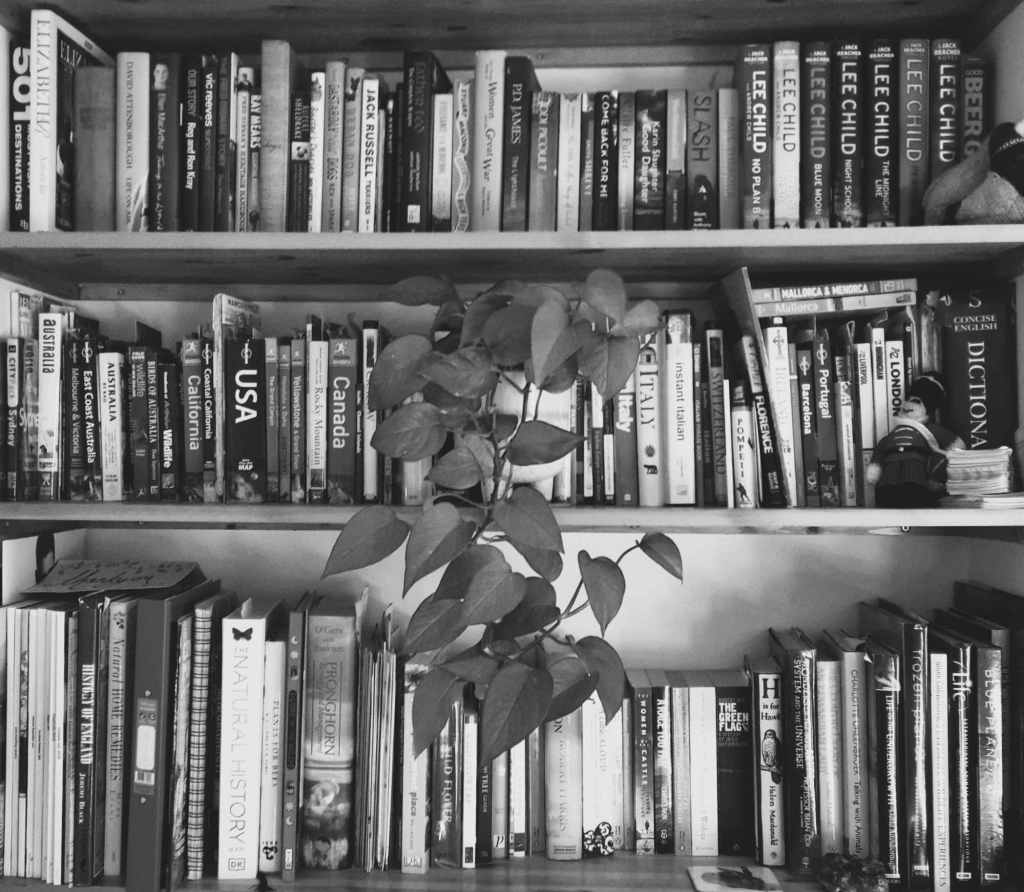
I’ve always loved books. Not just because another world exists in my hand and mind or that they teach or inspire, but they also look pretty beautiful on a shelf too. I believe there’s a word for people like me; bibliophile, from the Greek word ‘biblio’, meaning ‘book’ and ‘philos’ which signifies ‘friend’. And since disability and chronic illness hit I’ve devoured more books than ever, be it the physical form or audiobooks. So I thought I’d dedicate this post to some recent reads, all with nature themes.
Now seems the right time for a post on all things bookish as April 23rd is UNESCO’s World Book and Copyright Day. Starting in 1995, the focus of this day was to celebrate all things writing, publishing, book selling and of course much loved libraries. April 23rd was chosen as celebrated writers: William Shakespeare, Miguel de Cervantes and Inca Garcilaso de la Vega all died on this date.
In the UK there’s a Book Day on March 7th. I believe it was changed here due to Easter holidays and St George’s Day which also falls on April 23rd. So without further ado here are six nature books I’ve delved into over the last few months.

Entangled Life by Merlin Sheldrake
Published by Penguin 2021
★★★★☆
4/5 stars
I’ve wanted to read this 2021 winner of the Wainwright prize for some time and my copy is now full of sticky labels highlighting all the facts I found so fascinating and below is my review.
There’s something mysterious and magical about mushrooms; is it their dark and damp loving nature? The fungal networks that communicate with trees? Or the fact that some are edible and delicious and others deadly or hallucinogenic? This book is so interesting and written by a super knowledgeable biologist and plant scientist. He clearly knows his fungi and wants to share his love of it with us.
Each chapter deals with a different aspect of fungi, including: truffles, the wood wide web, mind altering fungi and many more. Each contains amazing facts, such as, ‘there are more bacteria in your gut than stars in our galaxy.’ I learned that mushrooms are the fruit of the fungi and many plants rely on fungi for their nutrients. And who would have thought some fungal spores reach speeds that are ‘10,000 times faster than a space shuttle after launch…’ I assumed before reading this book there would only be a few species of truffle, those culinary delicacies that are served up in fancy restaurants. Then I discovered there are thousands of truffle species and some even smell of ‘sewer gas or baby diarrhoea’. Hmm, think I’ll leave those off the menu. I love mind blowing facts that reinforce humans’ connections with the natural world and this book does just that. As I have a keen interest in invertebrates I particularly loved discovering about the mind altering fungi on insects and perhaps the most fascinating fact and one that will stay with me for a long time is learning about ‘zombie fungi’– a fungus which infects carpenter ants and whereby mycelium protrudes from the ants feet and attaches it to a plant. Then a fungal shoot pokes out from the ant’s head. There’s a photograph to demonstrate this too! The doomed ant is then consumed by the fungi but not before it’s behaviour turns completely bizarre, as if the fungi is controlling the ant’s mind. But you’ll have to read it to find out more.
There are a few photographs and illustrations and it would have been great to see more but the microscopic pictures of bread mould are fascinating – yes really. They’re like waffley mazes and other fungal artwork of lichens reminded me of a cross between coral and kale.
With all the remarkable facts, there were occasions where it went a little over my head such as some hypotheses and I felt a little fungi’d out. It’s an excellent book however, and if you enjoy in-depth topics on anything in our natural world, love facts and science, then I’m sure you’ll love this book too. Be prepared to be amazed.

The Instant by Amy Liptrot
Published by Canongate Books 2022
★★★☆☆
3.5/5 stars
One night whilst scrolling available audiobooks on my Borrow Box library app I came across a four hour memoir. Described as ‘exclusive essay’ about a girl who leaves the quiet Orkneys for Berlin and includes city wildlife, moon cycles and an obsessive love affair. Despite not being familiar with Amy Liptrot, the book sounded intriguing and anything Scottish or German has my name on it.
Amy Liptrot is a journalist and winner of the Wainwright prize for her first book The Outrun, where she writes about getting sober and recovering from alcohol addiction. The Instant follows on, and starts in the Orkneys. Thanks to her poetic writing I was hooked from the outset. She’s at a stage in her life where she longs for life. And love. So gets a one way ticket to Berlin to find it. Narrated by herself, it’s an honest account of how lonely a city can be, felt even more so when the language is not your mother tongue. She browses the Internet for potential lovers and anything that interests her. It’s nature writing with a difference – it’s not at the heart of the book but cleverly woven in throughout. And it’s this search for wildlife that I enjoyed the most. I knew Berlin’s parks and green spaces were home to goshawks but I didn’t realise raccoons also inhabited the city. As well as seeking out Berlin’s wildlife and a love interest, she recounts what captures her attention within the online world. There were times she reminded me of myself; following moon cycles on her phone, tracking planes on the Flight Radar app but most of all loving the wild, natural world. Think of this book as a travel memoir with nature writing, sex and tech. For this reason I found it a bit of a mish-mash. Just when I wanted to know more about racoons the subject would shift. That said, I enjoyed her writing, it’s full of emotion and passion. I’d say it’s more memoir musings than narrative. However, the drive behind her relocation to Berlin was to look for love and the possible outcomes of her a quest are: not finding love, finding love and living happily ever after or finding love and getting heartbroken. I’ll give you no spoilers here but there is an epilogue of her life now. So if you want nature writing that includes sex, drugs and Berlin techno with island and city wildlife thrown in, this book could be for you.
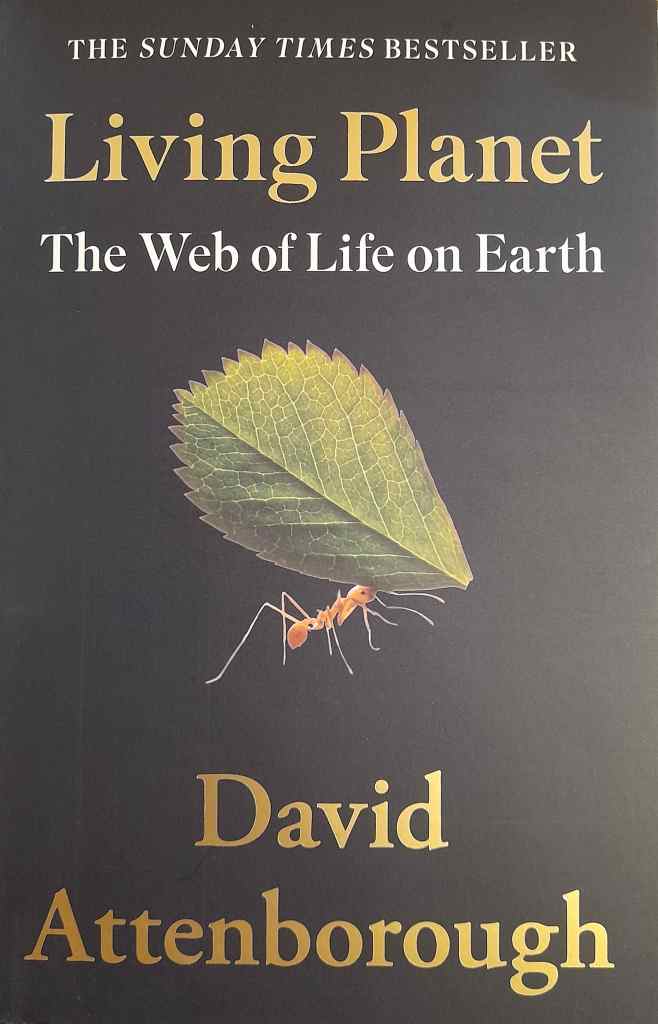
Living Planet – The Web of Life on Earth by David Attenborough
Published William Collins, Harper Collins 2021
★★★★★
5/5 stars
I discovered this extensive natural history book on my Libby library app and was over the moon to find out not only was it written by David Attenborough but narrated by himself too – brilliant! As I began to listen I felt a little sadness; this wonderful human being that has brought the wonders of the natural world to me ever since I can remember sounded ageing. I was aware he’s well into his nineties, (97 at the time of writing this) but his speech seemed slow, laboured, an effort even? Then an hour into the recording I realised the app for some reason was set at only 75% of the full speed! Restoring it to the correct speed my panic of his fragility was over. And I began listening to the David Attenborough we know and love, that soft confident voice full of wise words and knowledge filled my ears and below is my review.
This is an updated version of the book that was first published in 1984. It conjures up wonderful imagery right from the start; iridescent sunbirds with probing beaks feeding on nectar in Nepal and Tibet. What I really liked about this book is how it’s set out; each chapter is on a different environment rather than a country or a place, for example, grass plains and deserts.
The grasslands chapter was a hard listen in terms of man’s destruction of super herds: bison and my much beloved pronghorn antelope, the fastest land mammal in North America (50-100 million pronghorns slaughtered in the 19th century and bison far greater, if I remember correctly). The killing and near extinction of these creatures by European settlers stayed with me for days after listening, because the reason wasn’t for food, but to eradicate Native Americans. To say it’s a disturbing or an uncomfortable listen would be an understatement. More distressing facts followed; the last Great auk was killed by humans in 1844 and we learn how species are struggling against climate change – the equilibrium is upset. However, it’s not a book of doom but a book of wonder. You couldn’t write a book on the wonders of planet Earth without mentioning humans or what our effect on the natural world is doing. I travelled far and wide in my mind’s eye and learned about the mind blowing number of bird species in the Amazon. I was mesmerised by David Attenborough talking about the dancing birds of paradise and that an entomologist in Panama collected over 950 species of beetle in just one species of tree. David Attenborough shares with us how penguins got their name, how fossils and ferns were once in Antarctica and how the ice continent was once together with South America, New Zealand and Australia known as Gondwana. I also learned about the lives of ants and termites (which by the way aren’t related) and so much more.
As I listened in the dark to the world’s greatest naturalist of our time, with my earpiece in, I escaped our human world and found this book a journey of wonder. In my mind I travelled the planet from the arctic tundra, mountains, deserts and rainforests, visiting every continent and I had the main man himself as a guide. With this book there are no boundaries or borders, no politics or war, just a fascinating listen that lasted nearly twelve hours. Even after listening, I feel the need to have the physical book on my shelf and it’s definitely a must for any nature enthusiast or anyone come to think of it, as our planet Earth is still so rich. A highly recommended read, but if you listen to the audiobook, just make sure you listen on the correct speed!
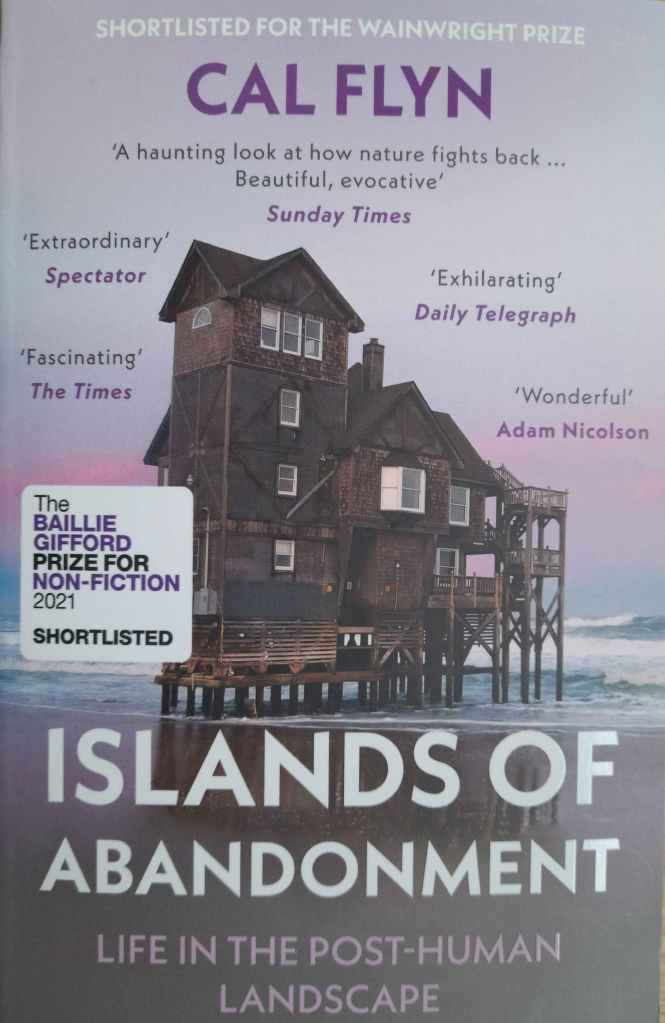
Islands of Abandonment – Life in the post-human landscape by Cal Flyn
Published by William Collins 2021
★★★★★
5/5 stars
This book was recommended to me by a nature writing friend and after reading the blurb about ghost towns, exclusion zones and uninhabitable places once humans have left pulled me in. I bought the physical copy and there’s an audio version which I’d love to listen to as it’s read by the author. It was shortlisted for the Wainwright Prize in 2021 and below is my review on a unusual subject.
We’re aware of dwindling wild spaces, the climate emergency and nature’s struggle to survive in this human world, but what happens once humans have left? This book looks at places around the globe that for some reason or other were once inhabited by humans but have now been left barren. It was a hard read in places in terms of man’s impact on our natural world; reading about war, agricultural run-off and pesticides, heavy metals, mining and the world’s most well-known nuclear disaster, Chernobyl. You can only feel grief for our planet and sickened at the way we treat it. However, I expected this book to be depressing and prepared myself for a bleak read but for all the truly shocking stories from around the globe it’s ultimately a book of hope. It’s riveting and the author takes us from spoil tips in West Lothian, Scotland, where we learn about succession; lichens, mosses and wildflowers to the Salton Sea, California, where a foul smelling place greets the author. She describes it as, ‘it is a poison lake whispering sweet nothings.’ This is a place where once migratory birds visited. We learn in 1999 10 million fish were washed up on the Salton shore and in 1996 10,000 pelicans were wiped out. It’s now a place for dropouts and those on the run and seeking life off grid. This is a book of many sickening statistics as a result of toxic substances, nerve agents, agricultural fertilisers, sewage to name a few. There is so much research and first-hand experiences whilst visiting these sites you feel like you’re there. We visit Scotland, Estonia, Cyprus, France, Montserrat, Ukraine, Tanzania and several places in the USA. Each and every chapter was compelling. It’s not only a book of destruction and how wildlife and nature can reclaim the land but it also touches on social history and what happens when economies collapse. I found the chapter on Detroit an eye-opener. The houses sit derelict in their tens of thousands, plants reclaiming them alongside squatters. This abandonment is referred to as ‘urban prairie’ and ‘blight’. In the 1950s the motor city had a population of 1.85 million and in 2019 the figure stood at 670,000. This gives you an insight into the scale of abandonment. And where there are empty homes, there’s crime. In parts it’s like reading a dystopian novel and then foxes, falcons and beavers make an appearance. When things become really grimy this book delivers chinks of light and life. The author meets people and guides along the way, those that call these places home and she described one resident’s feet as being ‘as gnarled as the roots of a tree’. There’s lots of this wonderful writing and in places it often feels more narrative than non-fiction. For example, chapter 10, The Trip To Rose Cottage is a chapter about Swona, a small island off Scotland. People have long left and all that remains are feral cattle. The author recounts when she was to stay in an abandoned cottage there and the boatman’s final words as he dropped her off were, ‘Stay in the house at night and lock the door behind you.’ A few pages later she describes ‘… a set of footprints which are not mine.’ If that doesn’t hook you in like some thriller novel I don’t know what will.
The imagery of desolate boarded up ghost towns and barren lands is prominent throughout the book and I could almost smell the decomposition in places. That said, the balance is just right. It delivers excellent journalism, that yes, is disturbing and shocking BUT there’s hope. How nature is finding ways to survive amid pollution and desolate land is nothing but remarkable and if this book doesn’t give you hope, be it on a personal or planetary level then nothing will. A must read for anyone that’s interested in humans, animals, the environment or just wonderful investigative journalism.
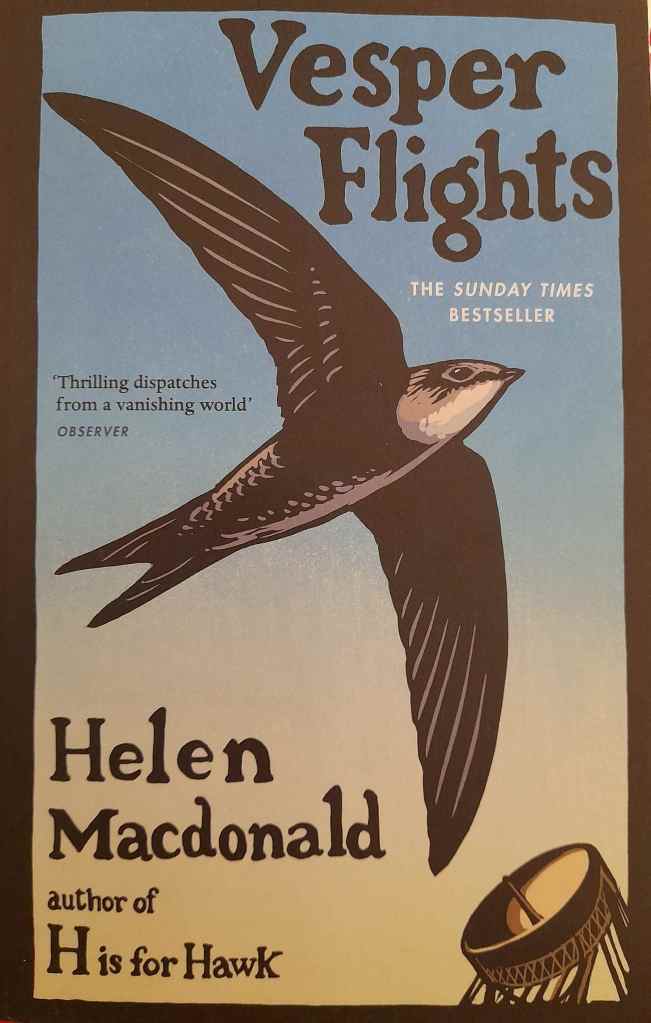
Vesper Flights by Helen Macdonald
Published by Jonathan Cape/Penguin/Bolinda audio, 2020
★★☆☆☆
2.5/5 stars
After perusing the Borrow Box library app I discovered this audiobook from award-winning author of H is for Hawk, Helen Macdonald. It’s described as ‘a transcendent collection of essays about the human relationship to the natural world’ and is narrated by the author. It totalled over ten hours of listening and depending on which essay I was listening to, my rating generally flipped between two and three, hence my overall 2.5 stars.
I wanted to like this book; I really did but found it a mixed bag. It’s often less about animals and wildlife and more about humanity and our actions. One of the most profound essays talks about a refugee, his hardship and perilous journey, hounded out of his country for his faith. Many essays in Vesper Flights are moving and all were melancholic in tone. But perhaps after listening to so many essays one after another, it felt a bit overload and combined with using many words I needed a dictionary for I ended up losing focus at times. This made it feel less inclusive, like perhaps you needed to be an academic to appreciate the author’s words or unravel what she was trying to say. I’ve never studied at higher education level and didn’t think this mattered when reading natural history memoirs and although I related to her anxieties on nationalism there were too many occasions where I couldn’t connect to the essays or the person behind them. Did I really need to know about the amount of blood spilled when a deer is hit by a car? Not really. In a later essay where the author describes her experience of stalking and scaring cows into stampeding, as ‘perfect’ and ‘… the most satisfying thing I had ever done in my whole life.’ Hmm? There were lots of bits like this and the brief essay about a goat was just plain weird and made no sense to me whatsoever. Maybe it’s because I listened to this after David Attenborough’s Living Planet and reading Cal Flyn’s, book, both hard acts to follow. But after ten plus hours I began to tire a little of the melancholy nature of these essays even when the writing was beautiful. Towards the end of each piece I knew there was a dark cloud coming. Of course it’s hard for us not to get down with the realities the natural world faces and the author reminds us of stark facts such as cuckoo numbers have dropped by half since the 1980s and how rich flower meadows are now housing estates. I’m not saying all nature writing should be happy, skippy, fluffy, not at all. I think the previous two books demonstrated that facts can be delivered in a way that motivates us to do something and gives us a glimmer of hope. However, with this collection of essays I felt there was too much gloom and sorrow with no balance. Maybe this is unfair because Vesper Flights is more memoir and opinion pieces that talks of humans interactions with the natural world and her life experiences. So negatives aside, there were great descriptions such as the essay Cherry Stones, where the author described Hawfinches as ‘finches on steroids’ and I particularly enjoyed hearing about the Golden Oriole and of course swifts. Some of the imagery is stunning but perhaps I would have got on better with the physical book to dip in and out of or maybe if the essays could have been more selective and only the very best ones chosen. All literature and the arts of course are subjective and these were just my thoughts but if you enjoy a varied collection of essays on themes of nature, life experiences and politics this book could be for you.
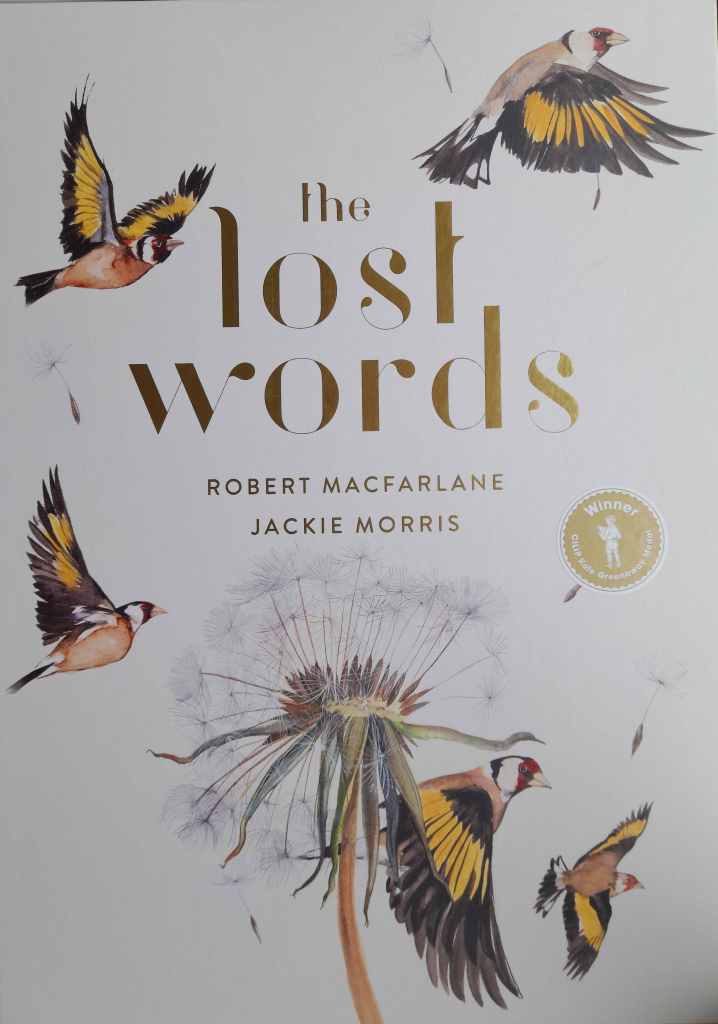
The Lost Words by Robert Macfarlane and Jackie Morris
Published by Hamish Hamilton 2018
★★★★★
5/5 stars
I discovered this stunning poetry book featuring the natural world in the ‘juvenile non-fiction’ section on the Libby library app. Children’s Book of the Year winner in 2018 and Sunday Times bestseller, this book is pitched as a book of spells and to be read out aloud but it’s not just for children…
The Lost Words starts by introducing words that have vanished from children’s vocabulary without anyone noticing: Acorn, Bluebell, Conker and Wren and so many more. How heartbreaking this is, that these once common words are being lost. But this book is bringing them back to life through poetry. I was so pleased I discovered it as it’s a gem to listen to. The poems are recited by Robert Macfarlane, Guy Garvey, Edith Bowman, Cerys Matthews and Benjamin Zephaniah – all with the perfect voices to read out these poems. Cerys Matthews is wonderful reading out the poems on Adder and Willow but perhaps one of the most relaxing experiences I’ve had recently is listening to Benjamin Zephaniah’s reading of the brief but beautiful poem on Bluebells. The way he delivers this delicate homage to the enchanting woodland flower makes me want to sit amongst these fairytale flowers. And after his sad passing in December listening to it again makes me want to read as much of his work as I can. But back to The Lost Words…
Sounds from the natural world are the audio backdrop to these beautiful poems and I particularly loved the poem on starlings which begins ‘Should green as moss be mixed with blue of steel…’ Hearing the starlings descending whistles and chatter in the background warms the heart. Between each ‘spell’ (or poem) there are pauses from words but not from the sounds of nature; birdsong, a bittern calling and a babbling brook are just some of the soundscapes. Together, the words and audio conjure up stunning imagery and are heartfelt. It’s hard to choose a favourite poem but after listening again and again I decided to buy the physical book for a nature loving friend that’s poorly. I had a little sneak peek before handing it over and wow! Jackie Morris’s illustrations are truly stunning. It’s a book to dip in and out of when you feel the need to immerse yourself in beautiful artwork and words relating to our natural world. At just forty-five minutes long my only criticism is that it’s too short. However, I’ve listened to it repeatedly and enjoyed it each time. Equally, to have the large hardback physical book I believe is the perfect addition to any bookshelf and if you love poetry, nature and art, no matter what age you are, I’m sure you’d love this book too.
“We read to know we are not alone.” – C.S Lewis
References
https://www.amazon.co.uk/Living-Planet-Web-Life-Earth/dp/0008477825
https://celadonbooks.com/inspiring-quotes-about-books-and-reading
Entangled Life by Merlin Sheldrake
https://www.flightradar24.com/apps
Islands of Abandonment by Cal Flynn
https://help.libbyapp.com/en-us/6103.htm
Living Planet – The Web of Life on Earth by David Attenborough
https://www.merlinsheldrake.com/about
https://www.nationaldaycalendar.com/march/world-book-day-march-2
The Instant by Amy Liptrot
The Lost Words by Robert Macfarlane and Jackie Morris
https://www.unesco.org/en/days/world-book-and-copyright
https://unesco.org.uk/events/international-days/world-book-and-copyright-day
Vesper Flights by Helen Macdonald
https://www.vocabulary.com/dictionary/bibliophile
https://wainwrightprize.com/news/2021-shortlist-announcement
I always enjoy reading about books, so the fungi book has gone on the wishlist. I found Cal Flynns book fascinating as well. It is interesting what you wrote about Vesper Flights. I started it but could not get into it so have given up. I may try again in a couple of years.
LikeLiked by 1 person
Thank you, I love to hear about books too & happy to hear of your recommendations for my wish list 🙂 That’s really interesting you tried Vesper Flights & gave up, I’m glad it’s not just me that found it a difficult read/listen. Helen Macdonald is a great writer & I kept thinking ‘is it me or the mood I’m in?’ But yes, sometimes giving a book a break & going back to it at a later time is worth trying. Thanks for taking the time to read & comment 🙂
LikeLike